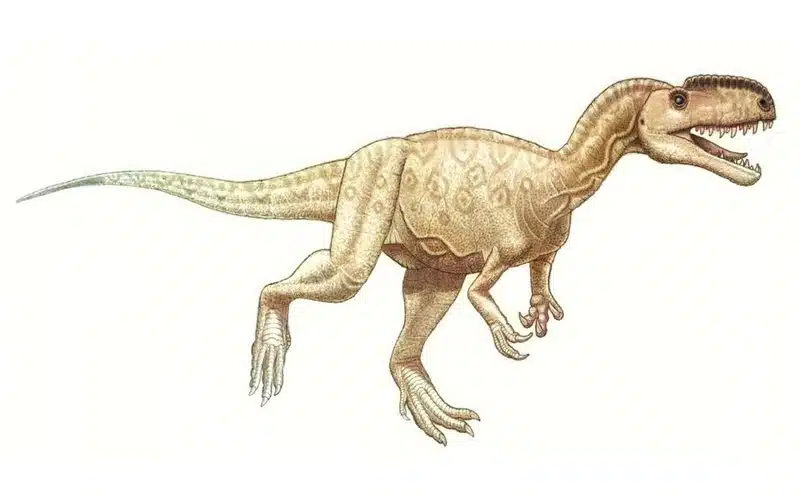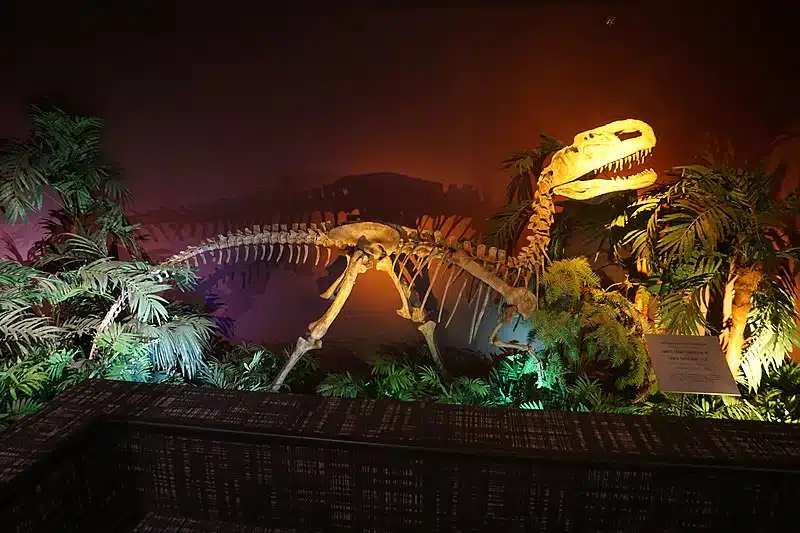Monolophosaurus, a name that translates to ‘Single-crested Lizard’ from Greek, is a fascinating subject in the world of paleontology. Discovered in the rich fossil beds of China’s Junggar Basin, this theropod dinosaur has intrigued scientists and enthusiasts alike since its first discovery in 1981. Its unique features, particularly the distinctive crest on its skull, have made it a subject of extensive study and speculation.
As we delve into the world of Monolophosaurus, it’s like stepping back in time to the Middle Jurassic Period, a time of significant evolutionary changes and diversification among dinosaurs. This journey not only enhances our understanding of this specific dinosaur but also offers insights into the broader ecological and evolutionary dynamics of its era.
Monolophosaurus Key Facts
| Keyword | Fact |
|---|---|
| Pronunciation | Mon-Oh-Lawf-Oh-Sore-Us |
| Meaning of name | Single-crested Lizard |
| Group | Theropoda |
| Type Species | Monolophosaurus jiangi (syn. M. jiangjunmiaoi) |
| Diet | Carnivore |
| When it Lived | 166.1 to 163.5 MYA |
| Period | Middle Jurassic |
| Epoch | Callovian |
| Length | 16.4 to 18.0 feet |
| Height | Approximately 4.5 feet |
| Weight | 1,047.0 pounds |
| Mobility | Moved on two legs |
| First Discovery | 1981 by Dong Zhiming |
| Described by | 1993/1994 by Zhao Xijin and Philip John Currie |
| Holotype | IVPP 84019 |
| Location of first find | Shishugou Formation, Junggar Basin, Xinjiang, China |
Monolophosaurus Origins, Taxonomy and Timeline
Monolophosaurus, whose name is derived from Greek words ‘monos’ (single), ‘lophos/lophè’ (a crest), and ‘sauros’ (reptile/lizard), is a testament to the descriptive nature of scientific nomenclature. This name aptly highlights its most distinctive feature: a singular crest adorning its skull.

Belonging to the Theropoda within the Tetanurae, Monolophosaurus jiangi stands as the type species of its genus. Its classification places it among the formidable carnivorous dinosaurs that roamed the earth during the Middle Jurassic Period.
The timeline of this dinosaur is particularly intriguing. It thrived during the Callovian, approximately between 166.1 and 163.5 million years ago (MYA). This era was a pivotal chapter in the Mesozoic Era, marked by significant geological and climatic shifts.
Discovery & Fossil Evidence
The journey to understanding Monolophosaurus began in 1981 with Dong Zhiming’s discovery of a nearly complete theropod skeleton. This significant find occurred during a stratigraphic exploration aimed at aiding the oil industry. However, the fossil remained buried until 1984, marking the start of a complex path to its scientific recognition.
Path to Scientific Recognition
Before its formal description in scientific literature, the fossil was initially referred to as Jiangjunmiaosaurus in the press, a name that later proved to be invalid. In the early 1990s, the dinosaur was mentioned in various forms, such as Monolophosaurus jiangjunmiaoi by Dong Zhiming and Monolophosaurus dongi by Wayne Grady. However, these names lacked formal descriptions, rendering them scientifically unrecognized.
It wasn’t until 1993/1994 that Zhao Xijin and Philip John Currie officially named and described the type species Monolophosaurus jiangi. The genus name, derived from Greek, meaning ‘single crest’, aptly refers to the distinctive crest on its snout. The specific name honors the location near Jiangjunmiao, an abandoned desert inn close to where the fossil was found, steeped in local legend.
The Holotype and Subsequent Studies
The holotype, IVPP 84019, was unearthed in the Junggar Basin, within the Wucaiwan Formation, dating back to the Bathonian-Callovian. This specimen is notably comprehensive, including the skull, lower jaws, vertebral column, and pelvis. However, it lacks the rear of the tail, shoulder girdle, and limbs, suggesting it was an adult or subadult at the time of death.
The type specimen underwent restoration, including plaster work for a travelling exhibit, which unfortunately hindered further study. Its left side was encased in foam, posing additional challenges for researchers. To compensate for the missing elements, a reconstruction was undertaken, allowing for the creation of complete skeletal casts.
In 2010, a significant stride in our understanding of Monolophosaurus came with two detailed studies by Stephen Brusatte and colleagues. These studies reexamined the holotype, which at that time was the only known specimen, providing a more comprehensive understanding of this intriguing dinosaur.
- Mounted skeleton in Japan
- The restored holotype of M. jiangi, on display at the Paleozoological Museum of China
- OLYMPUS DIGITAL CAMERA
- Bones and remains of prehistoric animals A replica skeleton of Monolophosaurus, a predator of the Jurassic Period.
- Monolophosaurus attacking a Bellusaurus, display at Tianjin natural History Museum
- Mounted skeleton of a Monolophosaurus attacking a Bellusaurus, Wyoming Dinosaur Center. The two taxa are from the same formation.
- A Monolophosaurus cast skeleton at the Milwaukee Public Museum in Milwaukee, Wisconsin
Monolophosaurus Size and Description
Monolophosaurus, a theropod of considerable intrigue, presents a fascinating study in dinosaur morphology. Its physical form, while sharing commonalities with other theropods, is distinguished by unique features.
Short description of Monolophosaurus
This dinosaur’s physique was built for predation. Its bipedal stance, streamlined body, and powerful limbs suggest a life spent in pursuit of prey. The most striking feature, the crest on its skull, might have served various functions, from display to species recognition.
Size and Weight of Type Species

The size of Monolophosaurus has been a subject of study and estimation. The type and only known individual of this species has been estimated to measure around 16.4 feet in length. In 2010, further analysis by Paul suggested a slightly larger size, estimating the dinosaur at approximately 18.0 feet long. As for its weight, it is believed to have been around 1,047 pounds. These dimensions paint a picture of a moderately sized Theropoda, agile and formidable in its Middle Jurassic habitat.
Monolophosaurus in Detail
Monolophosaurus, a remarkable theropod from the Middle Jurassic, is distinguished by several unique anatomical features. Its anatomy not only reveals much about its lifestyle and behavior but also contributes significantly to our understanding of theropod evolution.
Intriguing Skull Characteristics
The most striking feature of Monolophosaurus is undoubtedly its large crest, prominently displayed on its snout. This crest, primarily formed by the nasal bones, extends over three-quarters of the skull’s length, reaching the level of the eye sockets. Its triangular cross-section, with a broad base and a narrower top, adds to the dinosaur’s distinctive profile. The nasal crest’s rugose side, adorned with a series of bosses and swellings, suggests a complex biological function, possibly related to display or species recognition.
The skull of Monolophosaurus, measuring about eighty centimeters in length, reveals a fascinating array of features. The praemaxilla, at the front of the crest, has a unique forked rear that embraces a point of the nasal. This, along with other features like the distinct groove running from an opening in the ascending branch towards the nostril, highlights the dinosaur’s unique cranial structure.
Postcranial Skeleton: A Study in Adaptation
Moving beyond the skull, the vertebral column of Monolophosaurus consists of nine cervical, fourteen dorsal, and five sacral vertebrae. The cervical vertebrae are strongly pneumatised, indicating adaptations for reducing weight, a feature common in many theropods. The presence of pleurocoels and large air chambers within these vertebrae further underscores this adaptation.
The pelvis of Monolophosaurus also presents intriguing characteristics. The ilium, with a slightly convex upper profile and a hook-shaped point on its front blade, indicates a robust and powerful build. The unique structure of the hip joint, overhung by a hood-shaped extension of the antitrochanter, suggests a strong and efficient locomotion system, likely aiding in its predatory lifestyle.
A Glimpse into Theropod Evolution
The anatomical features of Monolophosaurus, from its distinctive skull crest to its pneumatised vertebrae and uniquely structured pelvis, provide valuable insights into the evolutionary adaptations of theropods. These features not only set the Monolophosaurus apart from its contemporaries but also contribute to our broader understanding of dinosaur biology and evolution.
Contemporary Dinosaurs
Life was a constant game of cat-and-mouse, especially with Yangchuanosaurus, a larger and more robust predator. Imagine two skilled warriors in a prehistoric landscape, Monolophosaurus, nimble and swift, often had to rely on its wits and agility to compete with the brute strength of Yangchuanosaurus. This dynamic was not just about predation but also about competition for territory and resources. The tension between them was like a tightly wound spring, ready to uncoil at the slightest provocation.
In this ancient drama, Mamenchisaurus played a role that was quite different. Towering above many, this gigantic, long-necked herbivore often grazed in areas where Monolophosaurus hunted. While Monolophosaurus was not nearly large enough to consider an adult Mamenchisaurus as prey, the presence of these gentle giants had a significant impact on the ecosystem. They shaped the landscape, creating clearings that Monolophosaurus could use for ambush hunting. However, young or sick Mamenchisaurus might have occasionally fallen prey to a group of Monolophosaurus, demonstrating the complex interplay between size, strength, and survival strategies.
Tuojiangosaurus, a sturdy, armored dinosaur, presented a different kind of challenge to Monolophosaurus. Smaller than Monolophosaurus, Tuojiangosaurus was like a walking fortress, its body covered in bony plates and spikes. The interactions between these two were likely a mix of cautious respect and opportunistic predation. Monolophosaurus, with its sharp teeth and claws, might have tested the defenses of Tuojiangosaurus, especially younger or less experienced individuals. This dynamic highlighted the adaptability and opportunistic nature of Monolophosaurus, constantly navigating a world where every contemporary, whether a towering giant, a formidable predator, or an armored tank, shaped its existence in this intricate prehistoric tapestry.
Interesting Points about Monolophosaurus
- Monolophosaurus’s unique crest is not just a physical hallmark but also a subject of scientific debate regarding its purpose.
- Its discovery in the Junggar Basin underscores the region’s significance in paleontological studies.
- The well-preserved skull of the holotype provides rare insights into the anatomy of theropods from the Middle Jurassic.
- The lack of complete skeletal remains leaves room for ongoing research and discovery.
- Its place in the Allosauroidea family connects it to some of the most well-known carnivorous dinosaurs.
Monolophosaurus in its Natural Habitat
Monolophosaurus inhabited an environment that was both challenging and dynamic. The Middle Jurassic Period, characterized by diverse ecosystems and fluctuating climates, provided a backdrop for this dinosaur’s existence.
As a carnivore, it likely played a pivotal role in the food chain. Its diet would have consisted of contemporary fauna, and its hunting strategies would have been shaped by the terrain and available prey. Monolophosaurus’s bipedal locomotion suggests a lifestyle of active pursuit, possibly hunting in packs or as a solitary predator.
The impact of this dinosaur on its ecosystem was undoubtedly significant. As a top predator, it would have influenced the population dynamics of its prey and possibly shaped the vegetation patterns through its feeding habits.
Frequently Asked Questions
Monolophosaurus translates to ‘Single-crested Lizard’, highlighting its distinctive skull crest.
It was first discovered in 1981 by Dong Zhiming in the Junggar Basin, China.
This dinosaur lived during the Middle Jurassic Period, around 166.1 to 163.5 million years ago.
As a theropod, Monolophosaurus was a carnivore.
The crest’s function is still debated, with theories ranging from species recognition to thermoregulation.
Its fossils have been primarily found in the Junggar Basin, Xinjiang, China.
Sources
The information in this article is based on various sources, drawing on scientific research, fossil evidence, and expert analysis. The aim is to provide a comprehensive and accurate overview of Monolophosaurus. However, please be aware that our understanding of dinosaurs and their world is constantly evolving as new discoveries are made.
Article last fact-checked: Joey Arboleda, 01-05-2024
Featured Image Credit: Jordan Mallon, CC BY-SA 2.5, via Wikimedia Commons







